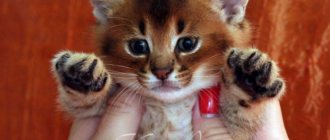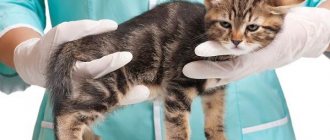Cats differ from people primarily in language and behavior. Of course, you cannot learn to speak the same language with a pet, but everyone can master the basic cat habits. This will allow you not only to better understand your four-legged pets, but also to be able to determine when they have health problems. How to decipher the basic habits of cats? What behavioral features of these animals should be a reason for a visit to the veterinarian?
The cat rubs against people and objects
Representatives of the cat family are also owners. It is important for these animals to have their own territory, which they protect from the encroachments of enemies by all available means. Cat owners also consider their owners their property. Cats rub against them or furnishings to secure ownership of them.
Friction is not a meaningless ritual. With its help, pets leave a special smell on friction objects, which, fortunately, the inhabitants of the home do not feel. Where does it come from? There are special scent glands on the cat's body (face, paws, around the eyes). When an animal rubs against something, they become active - and that something begins to smell. Feeling this smell, the cat calms down and feels confident in its abilities and that the enemy will not encroach on its territory.
The pet rubs against the legs, arms and even sometimes the face of the owner not only to mark him. Friction is one of the ways to show your loved one your tender feelings.
Communication of a cat with its relatives
As noted above, cats do not need to live with their relatives; of course, warm feelings may arise between animals from time to time, but they pass very quickly. Cats need their relatives only during the mating season or during the period of raising offspring, when the mother cat needs help caring for the babies.
There is a certain hierarchy in the places where a cat lives - the cat considers the dining room and resting place to be the house of the first order. Having explored these places, the animal quickly gets used to them and considers these places to be its property. The cat protects these places from any encroachment by other animals. If a cat has a very developed instinct of ownership, then it will be ready to fight just to drive away a competitor. The space around the first-order house is not so important for cats; around their houses, every animal can meet its relatives, but more often than not they do not communicate and try to ignore other cats and male cats.
During festivities, cats mark their own territory with special urine, which has an unpleasant and pungent odor. Any cat that enters this territory evokes sympathy from the male and he is ready to enter into a relationship with her. The period of walking for males is the most difficult period both for the owners of the cat and for the male himself. The owner has to endure the unpleasant smell and screams of the cat. For a cat, the period of walking carries many dangers because... he is forced to engage in real battles with other rivals for the right to communicate with the cat.
During the period of domestication of cats, their original instincts fade away and new habits appear, taken from the people who surround the animal. If a new cat gets into the first-order house of its relative, then the owner of the house will try by all means to drive out the uninvited guest. In such a situation, the cat that lives in the house will behave very aggressively towards the guest and will try to show the cat that this is her home and there is no place for other cats. The guest most often tries to find some corner or hill where he can hide and quietly observe the events taking place.
If two cats are brought into a new room where neither of them has been before, they will begin to study the situation and will not pay attention to each other. Only when the entire territory has been explored, the cats may want to communicate, or maybe each of them will simply find their place and pretend that they are alone in this room. In the first stages of acquaintance, when both cats are on equal terms with each other, they go through a certain acquaintance ritual:
- curiosity - each is interested in studying its relative and they carefully examine each other;
- the sense of smell increases, each of them tries to catch all the odors emanating from a relative;
- cats are at a distant distance from each other, they try to get closer to each other, stretching their necks towards each other and warily sniffing their relatives;
- If the first acquaintance was successful, then the next stage will be sniffing the most important places - the sides, back of the head and the place under the tail.
The further development of the relationship depends on the individual characteristics of each cat; most often, the more experienced and stronger cat begins to put pressure on the second and tries to subordinate him to his power. The second one in such a situation tries to escape from the meeting place as soon as possible.
It is a common belief that only cats from the same litter can live in the same territory for a long time and not conflict with each other. In all other cases, you need to understand that the more residents in one room, the more conflicts will arise between them. Even old cats who live together for a long time can conflict and fight. They have no concept of getting along with their relatives; relations will constantly move from the stage of reconciliation to the stage of war. Constant clarification of relationships between cats who live in the same room is explained by the fact that cats have a very independent character, it is very difficult for them to get along in the same territory with other cats and generally share their space with someone else. Already from birth, kittens are determined to have a leader in the litter; it is very easy to recognize him among babies - the leader always tries to take the most comfortable position near the mother or at the bowl. Such a kitten is not afraid to get into fights with its brothers and sisters, and is also the instigator of all conflicts in the litter. Such a character in the future will make a real fighter out of a kitten who will fight for his property and defend his space.
It is worth noting that there is no specific hierarchy between cats, and they do not choose their leaders, just one cat has the personal characteristics of a leader, and he displays them to the fullest.
Any attacks on the leader end in battle and intimidation of other cats. Most cats occupy the middle level, so to speak, they are not aggressive, they calmly treat their relatives and try not to get into fights without a reason. The middle link is the most common; cats that live in such formations get used to each other, they get food together, help each other wash themselves and clean their fur. The lowest layer is the cats who are afraid of the cats around them and cannot socialize. They do not approach the food bowl; at the sight of stronger felines, frightened cats run away and look for a safe place. If frightened cats live together for a while and understand that they are not in danger, they will be able to settle in normally and live next door to other cats.
It has been noticed that the younger the cat, the easier it is for him to get to know other cats, this is explained by the curiosity that is so inherent in young cats. Curious young individuals are ready to explore the world around them and get to know their relatives. Some cats become really close over time - they can share food, play and sleep together. It is not uncommon for an adult cat, most often neutered, to teach a young cat the principles of life. True, friendship most often does not last long; soon one of the friends begins to be jealous of the other cats and the friendship comes to an end. If you bring a young cat or male cat into a house where an adult cat already lives, the owners will most often be faced with several options for the development of events. The old cat begins to mark the territory and show with all his appearance that he is the master here, the old cat’s character deteriorates significantly, he begins to be jealous of the owners of the new pet and will take revenge on everyone. An old cat can intimidate a young cat and turn him into an angry and frightened creature who cannot live in the same room with another cat.
Cats have a very developed maternal instinct; they are ready to protect their children even if they can already fend for themselves. Each kitten is very important for its mother; the cat teaches all her children the tricks of cat life, does not allow fights between children and protects them from adult relatives. If two mother cats live in the same territory, then their maternal instinct extends to all kittens - their own and others. If one of the cats dies, the second takes in the orphaned kittens and tries to feed them all. When the kittens grow up a little, the cat begins to show aggression towards them, this is due to the fact that the cat’s milk disappears, and the kittens hurt their mother with their sharp teeth.
What does scratching mean?
In general, scratching in cats is often regarded as aggressive behavior. But this does not always indicate the bad character of the animal. If the kitten is small, then this is quite acceptable. After all, this is how he understands the world. Yet these “cute creatures” are predators by nature.
But sometimes even adult cats strive to bite or scold their owner. In this case, your pet has a very highly developed hunting instinct . He perceives your moving legs and arms as “prey.” To satisfy the desire of the “hunter”, purchase special toys for him.
Sometimes curtains and furniture suffer from scratching. Cats don't do this out of spite. When scratched on the surface, they remove old nail scales. And they also keep the paw muscles toned. Damaged furniture and curtains are not pampering for them, but a necessity. Therefore, you should think about buying a scratching post.
Other signs of cat favor
Cats often hide from strangers or even hiss at them, but they treat their own people more kindly. The cat's slowly closing eyes, the desire to play with the owner, and the location next to him on the sofa speak about a cat's trust and love. They understand very well who is their friend.
Buries food
Burying food is one of the most common habits in cats. Reasons for this behavior:
- Some pets bury food because they like it. This usually happens after changing the usual ready-made food for a new one or after the four-legged pet was offered a self-prepared dish that he had not tried before. Not knowing whether he will have a chance to taste the tasty treat again, the animal tries to hide it so that he can enjoy it again later.
Mating Features
Are you getting a cat for further breeding purposes? Then it will be useful to learn about all the nuances that precede the appearance of offspring. In large and small breeds, the age at which the first heat occurs varies slightly from 6 to 10 months. But it is important to remember that by this time the female’s body is not yet ready to bear cubs.
At one year and three months, cats become ready to bear healthy offspring. Like most other representatives of the fauna, mating occurs when the cat develops sexual desire. This is a short period of time, and is preceded by long courtship on the part of the cat.
At the moment of arousal, the female does not resist during mounting and coitus (mating). During conception, the cat clings to the female with its claws and grabs the withers with its teeth. All this happens in complete privacy so that people do not see.
During a normal pregnancy, a cat carries cubs for 7-8 weeks. Wild individuals have kittens once a year, but domestic ones can have more. On average, one litter is 6 kittens, but when a cat gives birth to kittens for the first time, in the vast majority of cases no more than two kittens appear.
Choosing a kitten
The habits of all cats are generally similar. But how can you find out about the character of an animal if it is a small kitten? How to determine who we choose for ourselves?
There is a theory according to which hormones influence their development. They have an effect on both the body and behavior. Therefore, these two factors are connected, which means that the kitten must be selected based on the expression of its face.
When choosing, you also need to pay attention to your parents. Since kittens are constantly with their mother while growing, they have time to learn basic skills.
Scientists have proven that cats - fathers influence habits and preferences even in the embryonic period. Therefore, if possible, take a closer look at your parents.
The breed plays the biggest role in a cat's character. Therefore, first of all, you need to choose a suitable breed. The period of socialization of a kitten takes place in the first four months. All the skills he can acquire will last a lifetime. Therefore, the owner’s task is to teach his pet everything necessary. And in the end, get maximum positive energy and joy from communicating with this independent creature.
Factors influencing cat behavior
All cats behave differently. This is due to many factors:
- character and temperament, which largely depend on the breed. Thus, Siamese cats are jealous and capricious, but Maine Coons are kind, so they are best chosen by families with children. Outbred cats can have very different personalities, because it is not clear from which breeds they originated;
The behavior of a cat depends on the breed, for example, Maine Coons are generally friendly
- education. For a cat to grow up kind and affectionate, you need to talk to it, play with it, and take care of it. And on the contrary, for owners who devote little time to the animal, it can behave vindictively - shit in the slippers and on the bed, etc.;
- socialization. Sociopathic cats do not accept anyone at all (they do not allow themselves to be stroked, do not make contact, etc.), except perhaps the owner when he offers food. It is usually not easy with such animals, but at the same time they do not require much attention;
- trust in people. If you call a cat on the street, he may not come up because he is afraid of humans. This is usually how pets behave. And those who do not have a “roof over their ears” usually run up to be fed, but not all of them either. If a cat has been frequently abused, it may be afraid of everyone around it and not approach a person. Such stressed animals need rehabilitation - they need to be gradually accustomed to normal relationships with humans.
A cat living outside may be scared, which may cause her to not trust humans.
Crushes the owner or upholstered furniture with his paws
Cats mash their owners with their paws because:
- they feel completely safe, just like in childhood, when, as kittens, while feeding, they kneaded their mother’s breasts with their front paws to increase the flow of milk to her nipples;
- they experience true pleasure, and the only way to express gratitude and love to the owner is to sit on his lap and look into his eyes, touching his paws;
- they want to protect a loved one from invisible enemies, leaving odorous marks on him with the help of sweat glands located on the paw pads;
- do therapeutic massage.
These animals crush furniture with their paws to:
- prepare her for bed;
- relieve stress (rhythmic, monotonous movements help them quickly calm down);
- realize sexual instinct during the mating season;
- mark the object of trampling.
Communication between cats and other animals
In the cat's worldview, all animals that come across a cat's life receive the status of either a pursuer or prey. Scientists have long proven that a cat considers almost all animals it meets as its relatives. Only after finding out by smell that the animal is weaker than her, she understands that this animal is prey or, conversely, the cat is prey. The older the cat, the easier it is for her to distinguish her prey from her pursuer. When a cat lives in a natural environment, it is easier and faster for her to understand who is friend or foe in the yard. Country cats almost never show interest in poultry. They can show their maternal instinct not only on kittens, but also on babies of other animals - piglets, kids, etc. A cat calmly reacts to large animals - cows, pigs, she understands perfectly well that she is not in any danger from them. Cats develop friendly relations with some neighbors in the yard, and in winter the cat can bask in utility rooms along with other animals.
Little kittens, due to their curiosity and ignorance, can even mistake hamsters and parrots for their relatives. A kitten can play with a hamster, but if the baby’s instincts awaken, the little friend may be in serious trouble. But this does not always happen; there are cats that can live peacefully with a white rat, even if it moves around the apartment without obstacles.
The complex and contradictory relationship between a cat and a dog deserves special attention. In most cases, living in the same house with a cat and a dog is peaceful and without quarrels. But there are other cases when quarrels and showdowns begin between neighbors. Enmity between two animals occurs due to the manifestation of the instincts of each of them. Dog owners influence this relationship; some owners set dogs against street cats. If dog owners do not set their pets against street cats, then a completely friendly relationship can develop between a dog and a cat. There are times when a cat meets its four-legged friend in the park or simply sits at the entrance and waits for the dog to be taken for a walk. A running cat makes the dog want to rush after and catch up with the fleeing object. Even if a dog catches up with a cat, it almost never harms it. Cats are quicker to navigate dangerous situations and can do something that will greatly surprise or even frighten the dog. Having overtaken a cat, the dog most often simply barks at it, but does not dare to attack.
If you take a puppy and a kitten into your home at the same time, then they will grow up to be true and devoted friends who will rarely argue and will mostly exist peacefully with each other.
An old dog can also easily get along with a young cat - in this case, the dog’s maternal instinct awakens, and the kitten perfectly replaces the puppy. Dogs can generally replace a kitten’s mother and take full care of the baby. The kitten perceives the dog as its mother and does not feel any danger from it, realizing that the baby can do whatever he wants, he begins to indulge in every possible way and anger the dog. The kitten often takes tasty food from the dog’s bowl, scratches the dog’s nose, bites the dog’s tail painfully, etc. The dog in such a situation is patient and humbly waits until the baby grows up and stops being a bully. If the kitten is confident in his big friend, he can calmly fall asleep on the dog's stomach, knowing that he is completely safe and under strict protection. In principle, with a strong desire, even adult dogs and cats can be made friends, it will just take more time and effort.
Over time, the cat stops paying attention to the dog’s barking and clumsy movements, and the dog eventually stops hunting the cat. Cats are often more liked by their owners than dogs. Cats are allowed to sleep in the owner's bed, their food always tastes better - this and much more hurts the dogs, because in the relationship between pets there is always a competitive moment, and when the cat receives more attention from the owner, the dog begins to play pranks and attract the owner. During such periods, apathy on the part of the dog, bad mood and even refusal to eat are possible. Cats love to tease dogs; it happens that a cat starts playing with a dog, winds it up, cheers it up, and then just quietly leaves the angry dog. At such a time, the dog is ready to do anything just to play with the cat.
How can you understand your cat by gestures?
Love for animals is a better means of understanding behavioral reactions. I do all of them automatically:
- Nervous twitching or sharp wagging of the tail expresses dissatisfaction;
- raised tail (slightly curved) – good mood and trust in others;
- when frightened or confused, the tail is tucked or fluffed, if the animal is ready to attack another cat or dog (in this regard they are more ferocious), it also hisses with its ears tucked back;
- if the tips of the ears are apart, she is perplexed, raised to the top of the head - a decision has been made, directed forward - interest or recognition of signals.
Sometimes cats scare their owners with their behavior. For example, in complete darkness, when the light comes only from a monitor or gadget, the animal peers at one point with sharply dilating pupils. This does not mean that the cat saw a brownie there (although it is possible); most likely, a spider is descending, the cat is “sharpening.”
Animals are no less emotional than people; they suffer from loneliness in a closed apartment and entertain themselves as best they can. Sometimes they stare at one point for a long time, “freeze”, withdrawing into themselves - the consequences of the stress they have suffered.
Some mark their territory endlessly, others don’t; perhaps they don’t like the smell of a smoky apartment. There are many signs and interpretations of their behavior, so you should not punish the animal. Just try to understand it - look at the world through the eyes of cats.
Behavior after sterilization and castration
The cat is not only an affectionate pet, it is considered one of the most dangerous predators for its size. Therefore, cat aggression can be dangerous for other pets and for humans.
One of the reasons for aggressive behavior is sexual activity. Failure to satisfy this need leads not only to behavioral disorders, but also to nervous disorders. The problem is solved by castration or sterilization.
After surgery, the animal behaves unusually. First, it recovers from the anesthesia and sleeps a lot. Experienced stress and discomfort from surgery often lead to refusal of water and food for the whole day.
It is safer to spend the first day in a carrier under the supervision of the owner. This will protect against possible injuries. The effects of anesthesia often lead to inappropriate behavior, loss of coordination, and changes in perception. In this state, the cat runs the risk of falling out of the window or falling off tall objects.
Even a litter-trained pet may suddenly “forget” its toilet after surgery. Don't scold him. The reason for this behavior is the stress experienced. In addition, the usual tray and filler may seem uncomfortable to the pet during the healing of the sutures. Be tolerant of the animal, try to calm it down. You may need to temporarily replace the litter or tray. Don't overdo it with hygiene: too thorough cleaning of the toilet destroys the animal's usual smell. Detergents cause allergies or skin irritation.
Animals that have been sterilized when young are more likely to become affectionate and do not show aggression. An operation in adulthood affects character less noticeably: it has already been formed. But most neutered animals are less prone to mood swings and get along better with other pets. Some cats become more aggressive immediately after surgery. This is a reaction to stress and discomfort.
Be patient, provide a calm, comfortable environment, and pay more attention to your pet. He needs time to recover and calm down. If behavioral disturbances or depression do not go away after a month, contact your veterinarian.
Don't forget about proper nutrition. It is necessary to restore and maintain health after surgery. Consult your veterinarian, he will help you create a diet. PRO PLAN® VETERINARY DIETS CN CONVALESCENCE is ideal for nutrition after surgery. It is well absorbed thanks to the special formula. And the high calorie content and increased protein content will support the pet’s body during the recovery period. PRO PLAN NUTRISAVOUR STERILISED food has been developed for feeding sterilized and neutered animals. It supports the health of the urinary system thanks to its high moisture content and a complex of minerals. Antioxidants enhance the body's natural defenses. And the special formula helps maintain a healthy weight: it contains a lot of protein and little fat.
Read more about sterilization of cats and female cats in our article.
Habit of climbing higher
The habit of climbing on high objects (not every cat has this feature) has 2 justifications:
- Felines do this to realize the territorial feeling inherent in nature. These animals adhere to a hierarchical model of relationships. The owner of the territory climbs to a height - this way he can take in all his possessions with his gaze, which allows him to control the situation and, if necessary, descend, subjugating other relatives or entering into battle with them.
- Cats climb to heights because they feel in danger, which comes, for example, from a dog.
Hiss
You don't need to be an expert in cat psychology to understand that hissing, high-pitched meows and growls are the animal's declaration of impending danger.
Seeing a neighbor's dog or cat, the pet may begin to defend its territory by making growling sounds. My cats react this way when puppies try to play with them: they don’t release their claws, but they scare them off with hissing and growling.
Sometimes an animal can react this way to an unfamiliar object: a hair dryer, a vacuum cleaner, a washing machine. If a cat hisses at someone on the street, it could be a hedgehog or snake lurking nearby.
Why do cats hiss when they sense danger?
Many people have repeatedly witnessed “cat fights.” When a cat attacks an enemy, it presses itself to the floor, lowers its ears and emits a terrible hiss. This is explained by the fact that cats are able to imitate and imitate various sounds. Therefore, smart animals chose to imitate a creature that they are practically afraid of - a poisonous snake. The cunning cat's brain understands that hissing is intuitively associated with a snake. That is why, in order to scare the enemy, the cat hisses.
1) Cats can imitate small children
Cats have a large number of ways of communicating, but basically, if a cat wants something from us, it meows. For example, when she wants to say: “I’m hungry”, “Pay attention to me”
or
“I just did something, go clean it up
,” she makes peculiar sounds. Unlike dogs, who always bark the same way, cats know how to use different pitches and volume levels of their sounds, so they are better able to manipulate us to get what they want.
Recent research has shown that by listening to recordings of different cats in different situations, people can subconsciously determine when a cat's meow is expressing a request or when it is simply meowing. Participants in the experiment reported that begging sounds were faster and less pleasant to the ear than normal meows, just as a baby's cry when hungry can be unpleasant.
Interestingly, the cat's meow of a hungry cat, which requires food or attention, surprisingly resembles the sounds of a screaming baby in frequency. Apparently, this is not just a coincidence - but a real cunning of cats. Cats have become adept at using sounds at a frequency that will make their owners react faster.
And we react quickly, like well-trained animals, because these sounds not only irritate us, they awaken natural instincts in us.
Love for drawers, boxes and cabinets
What does it mean that cats love boxes, drawers and cabinets and have an irresistible desire to hide in them? This feature is explained by the desire for privacy. This habit was passed on to modern pets from their wild ancestors, who were forced to live in harsh conditions, sometimes hiding in secluded places from the predatory animals that hunted them.
In a residential area, cats are not in danger of becoming victims of an enemy, unless we are talking about them living in the same territory with dogs with whom they do not have a good relationship. However, they retained the habit of hiding in secluded places.
Acquired habits of cats
Not all cats allow their owner to pick them up. This habit needs to be gradually instilled in them. There are simple and effective recommendations on how to accustom a cat to being handled so that it is affectionate and friendly:
- Accustoming a pet to your hands should begin at the age of a kitten, because accustoming an adult cat is much more difficult;
- It’s better to do this gradually, first you need to talk affectionately to the furry pet, stroke it behind the ear, after which it can jump into your arms, do not grab it and hold it by force;
- A cat's weakness is tasty food, when the cat eats calmly, you can try to stroke it, and a well-fed cat falling asleep can allow itself to be taken on your lap.
And about one more acquired habit. Pet owners are interested in why cats respond to kitty cats, even those that live outside. It turns out that everything is very simple - it’s a matter of habit; they’ve heard this call since childhood. In other countries, cats do not respond to this form of calling. For example, in France, a cat is attracted by the call “minu-minu”, in the Czech Republic – “chi-chi”, in America – “kiri-kiri”, in Italy – “michu-michu”, and in Korea – “nabiya-nabiya”. Fortunately, cats from all over the world respond in the same native cat language.
The popularity of cats is explained by their beauty, cleanliness, grace, dexterity and playfulness. Moreover, each pet has different behavior, habits and disposition.
And no matter how cats try to show their independence, they urgently need the attention and affection of their owner, and if this is lacking, they suffer. The owner should show not only understanding, but also patience with the peculiarities of the cat’s behavior, and then the domestic cat will reward him with devotion and affection, and at the right moment, she will calm her down and lift her spirits. Read interesting facts about cats.
Description of the Scottish Straight cat
Scottish cats differ in a number of characteristic features that are unique to this breed. Sometimes animals are often confused with the British species, but during the comparison process the following differences can be identified:
- more rounded head;
- the body has an oblong and elongated shape, which gives the animal elegance;
- body proportions are slightly reduced;
- the average weight of a cat is 3 - 5 kg, boys weigh slightly more than females;
- pets are very flexible and remain hardy and playful at any age.
The cat brings caught mice, birds and even rats - dead and half-dead
If a cat brings caught rodents and birds to the owner, most likely, in this way she shows maternal feelings when all her forces are aimed at finding food for the cubs. Some animals, with the help of such an original gift, which seems quite appropriate to them, show their owners their tender feelings or gratitude.
Another reason for this behavior is the animal’s desire to teach its owner hunting skills. For this purpose, the pet does not bring killed, but only strangled mice and birds.
6) The cat brings dead prey into the house to teach you how to hunt
Cats love to kill. Many owners who let their cats go for a walk are surprised to find that their pets bring their prey into the house and show it off to their owner. Do you think that the cat wants to share what it caught with you?
Many cat owners will say that cats are instinctive hunters, and even when they've had their fill of canned tuna, they won't mind hunting a flying sparrow just for fun if the opportunity arises. After a successful hunt, the proud animal presents the prey to the dominant leader of the group (usually the owner) as a gift.
Although this is quite logical, this assumption is a little wrong, and this is only half the story.
In fact, a gift in the form of a dead bird or mouse is not a gift for the owner at all, it is more like a training exercise. Cats teach their kittens and other dependent family members how to hunt and catch prey by following gradual steps. When your cat drops prey at your feet, this is lesson number one in his training program. The cat notices that you have almost no hunting skills and are unable to catch your own food, so she tries to train you, as she does with her kittens.
Places itself to rest in the most inappropriate places (aisles, on the keyboard, etc.)
Pets sometimes disturb the inhabitants of the home, resting in the passages, occupying the space near interior doors and computer keyboards. Is there any special meaning to this behavior? The tendency of cats to settle in inappropriate places can be explained by the desire to mark boundaries.
Representatives of this family consider the territory on which they live, as well as everything that is on it, to be theirs. By being located in doorways, they demonstrate to the inhabitants of the home, including other animals, that it belongs to them. In addition, by staying in the passages, cats try to cool themselves, since it is in such places that air circulates best in the house. They usually behave this way in the warm season or if the home is too hot.
Perhaps this behavior is also due to the fact that the pet, clearly disturbing the inhabitants of the house, is trying to attract attention to itself in such a simple way. Indeed, it’s hard not to notice the cat, which is sitting imposingly on the keyboard. You shouldn't chase him away. It is better to take your four-legged pet in your arms and spend some time with it.
Behavior
There are certain cat habits, some of which can be interpreted by knowing cat psychology.
- When an animal follows you with its tail, it’s a sign that it’s time to pay more attention to it.
- If a cat rubs against you (attracts attention), and then turns around and raises its tail like a pipe, it means that she is inviting you to sniff her, that is, to get to know her better.
- Pets often choose a sleeping place based on safety and good visibility. Don't drive them away from their homes.
- If your belongings are periodically occupied by a sleeping cat, this is a sign that she loves you and is looking for a place with the scent of her owner.
- After bringing prey into the house, cats often meow. This is how they teach the kittens to “proper nutrition”, and when there are no babies in the house, they can try to treat the owner to new food.
Harmful cat habits
Not all cat habits are liked by owners; some habits create difficulties for people keeping a pet in an apartment:
Scratching furniture
Sharpening their claws is a natural need, this is how animals remove excess length and clean off the stratum corneum. It is necessary to install a scratching post and teach the cat to use it, strictly preventing attempts to tear up furniture, wallpaper, carpets, and floor coverings.
Tags
Sexually mature cats leave fragrant business cards on the corners of walls, legs of tables, and cabinets. This is how they indicate their right to territory and declare to females that they are ready to mate.
The acrid smell of the secretion is difficult to evaporate, absorbing into the surface. To avoid an unpleasant spirit in the house, to save yourself from unnecessary suffering, and the animal from illness, attempts to break free, it is recommended to castrate the cat. Especially if the owners do not plan to engage in breeding.
Eating out
Cats walking outside on their own can eat offerings from compassionate passers-by and food waste. Stale food causes poisoning, infectious diseases, indigestion, and vomiting. Particularly dangerous are the linings of “cathunters” stuffed with crushed glass and the points of fishing hooks.
Be sure to read:
How to scare cats away so that they don’t shit, mark and damage furniture, what smell they can’t stand
Utility companies leave out poisonous food to kill rats, but cats can also fall prey to coumarin. It is necessary to feed your pet well before leaving, and it is better to prevent self-walking.
Talkativeness
Intrusive meowing can be irritating for some owners. In this way, the cat signals hunger, fear, anxiety, and pain. Increased talkativeness is unusual for cats; once you figure out the reason, the animal immediately stops talking.
Keeping cats is a fascinating process; intelligent animals adopt the atmosphere of the house and their owners. It's funny to watch them play, fuss with children or other pets, and develop their character as they grow older. Some cat habits have become an inexhaustible source of memes, jokes, and funny videos. Share in the comments which pet habits you like and which you don’t?
What nuances regarding cat hygiene, sleep and nutrition should the owner know?
So, it's time to figure out how to care for a cat at home and why this process is considered simple. Minimal care is explained by the cleanliness of the animals; cats carefully lick their fur with their tongues, and kittens begin to wash themselves from the thirtieth day of life. But you still need to monitor the condition of the pet’s coat and body, maintain hygiene, and take care of its health. Particular attention should be paid to your cat's ears - they should always be clean.
It is difficult to give a specific figure for how many hours a day cats sleep, since it depends on the age, character, mood, and size of the animal. Definitely, cats sleep twice as much as people. Some cats can sleep up to 22 hours, and this should not disturb the owner. The average duration of daily sleep can be 13-16 hours, that is, two-thirds of a cat’s life is spent sleeping, and in this they have no equal among other animals.
Once a cat refuses food for a day, a caring owner is immediately concerned with the question of how long the cat can live without food, without harm to its body. Practice has proven that a week's fasting cannot negatively affect the cat's body. However, if an animal does not touch food for two weeks, this will have sad negative consequences, since irreversible processes and changes begin in the body.
Sometimes he curls up into a ball, sometimes he stretches out in his sleep.
Curling up in their sleep is a typical behavior for many cats. It is not difficult to understand why they choose this particular position. Curling up into a ball, tucking their paws under them and wrapping their tail, they just want to keep warm. Animals usually sleep this way in the cold season and when the house is cool.
Another reason for this position in sleep is to protect the internal organs from a possible attack by the enemy. Modern representatives of this family inherited this feature from their wild ancestors, who, even in a sleepy state, were on alert so as not to become prey to predatory animals. Pets are not in danger, but they still sleep curled up in a ball.
Sleeping animals periodically stretch out to stretch their stiff bones. This position indicates that the four-legged pet feels completely safe. Cats sleep in the same position when they are hot.
How to choose the perfect cat
It will not be possible to choose an ideal, since each owner has his own idea of the ideal. For some, the most important thing is a kitten’s playfulness, for others – complaisance and learning ability.
The most important advice that can be given to a future pet owner is quite simple. You need to follow your inner instincts and choose a kitten that you like. Even if you make a mistake with your choice, your character can always be corrected by upbringing and showing care and love for the animal.
Cats of different breeds
The director of the pet salon, Natalya Khabarova, will talk about how to determine temperament and understand what kind of character a particular cat may have.
Features of behavior, when they appear, you need to take your cat to the veterinarian
It is recommended to show your pet to a veterinarian if he:
- Tucks tail to stomach, trembling and spending most of the time lying down. This may indicate the development of diabetes or spinal problems.
- He behaves nervously, constantly licks himself, his tail muscles twitch.
- Constantly snorts and rubs his nose with his paws, which may indicate a runny nose, sinusitis, inflammation of the tooth root, or a foreign body getting into the nasal passages.
- He hides and avoids communication in every possible way or, on the contrary, persistently tries to climb into his arms.
- Shows unmotivated aggression.
- Doesn't allow anyone to touch him.
- Meows constantly.
- He hits the wall with his head, freezing in this position.
- Moves sideways, backs away, crawls away, clinging to the floor.
Share with friends!











